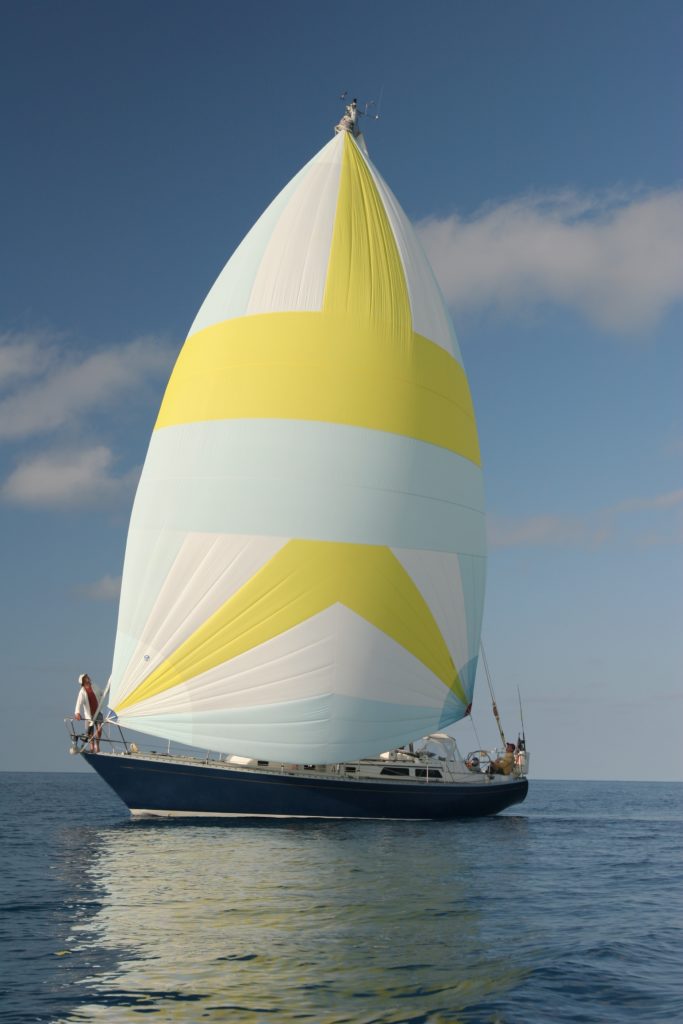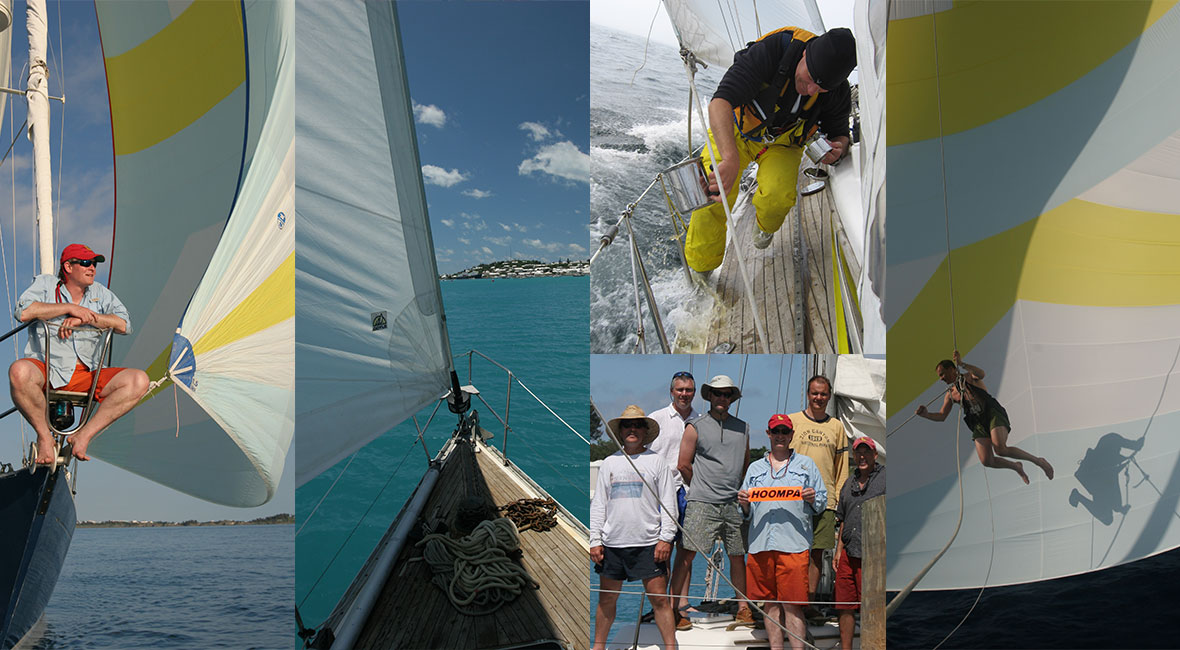From left to right: Peter Barba on the bow of the The Tioga; the boat approaching Bermuda; Josh Antrim washes a coffee pot; crew members, from left, Josh Antrim, Tom Gutermuth, John Fulghum, Peter Barba, Philip Kersten and David Liscio mark their arrival on land with a flash of a HOOMPA bumper sticker; and, Philip Kersten aloft on the sail of his 44-foot sloop.
by DAVID LISCIO
WE WANTED TO GO TO BERMUDA.
No big deal. Friends said we could fly there from Boston in two hours. But that wasn’t what we had in mind.
We wanted to sail. We envisioned being carried southeast by the wind, crossing the cobalt Gulf Stream, and staying on course until we spotted the green speck of land in the middle of the Atlantic Ocean. Admittedly the plan sounded farfetched, probably because it was hatched over too many beers, but six of us decided to make it a reality.
Nahant sailor Philip Kersten quickly convinced us to consider Tioga, his rugged 44-foot sloop designed by the legendary John Alden, aboard which a previous owner twice crossed the Atlantic. Within days, the crew consisted of six Nahanters — all middle-aged men, friends and fathers. Besides me, the nautical scribe, there was Capt. Kersten, a program manager who would go on to sail many corners of the world aboard Tioga; corporate projects supervisor Tom Gutermuth, engineer Josh Antrim, scientist John Fulghum, and bank facilities manager Peter Barba.

We were all looking for adventure, something out of the ordinary, and perhaps a chance to feel like pirates, if only for a week.
Before heading out to sea, we divided the crew responsibilities and attended a safety workshop in Rhode Island that focused on bluewater survival skills. We also honed our emergency first-aid knowledge — splinting, bandaging,even practicing how to suture by using pig’s feet.
The GPS and binnacle compass pointed the way, but we knew a lot could happen along a nearly 700-nautical mile route of open sea. We had charts, but they were of little use until we reached the jagged reefs that surround Bermuda.
Relatives and friends helped bring the remaining provisions aboard, wished us luck and waved us off from Nahant’s Tudor Wharf. It was early June, but summer in New England was nowhere in sight. As we sailed across the rich fishing grounds of Stellwagen Bank, I lightly gripped the wheel and savored the moment, tuning my senses to the glittering night sky, the briny air, the sound of Tioga rhythmically lunging through the waves.
We had a vague idea about where to enter the Gulf Stream, the warm river that flows diagonally northeast at about four knots, from Mexico’s Yucatan Peninsula to Ireland’s underbelly at County Cork. On the third day of our trip, the GPS showed we were approaching it.
The stories we’d heard about sailing to Bermuda were fresh in mind: crashing waves in the night that can pitchpole a yacht in seconds, opposing wind and sea conditions that can translate to 30 hours of rough Gulf Stream crossing. And then there was the Bermuda Triangle, which mysteriously sucks boats into Davy Jones’ locker without warning. We’d be skimming across waters that some folks contend are the devil’s playground, given that Bermuda is the northernmost point on the spooky Triangle.
But it was the Gulf Stream’s legacy of fickleness that left us with the most uncertain feelings as we watched the water temperature gauge rise from 78 to 90 degrees Fahrenheit in a matter of minutes.
Based on what we’d been told, the water would change color from the inky North Atlantic to an inviting cerulean blue. But it didn’t happen instantly. The color certainly became bluer, but more obvious was the warmer wind and water. We shed our foul-weather gear and stripped down to shorts, T-shirts, inflatable life vests and tethers, since we all abided by the rule that when on deck, you clip onto the safety lines.
As we entered the stream, we were careful to avoid sailing against an eddy — one of the swirling pools of water moving opposite to the current — knowing it would be far more comfortable to go with the flow.
For nearly a full day we sailed through the stream, lifted by endless swells. We felt the sideslip caused by a current trying hard to push us to Portugal. Like something out of the movie “Finding Nemo,” a sea turtle three feet in diameter rose to check us out, as did schools of compact bottleneck dolphins, so different from the porpoises that swam along with us north of the stream.
On the far side of the stream, we were many miles off course. The water temperature dropped again into the high 70s and the boat straightened out, giving us reason to open a bottle of Mount Gay rum and celebrate. It was only 8 a.m., but everybody was game. I plugged my iPod into the portable speakers and cranked up “Blow the Man Down,” a rollicking shanty from the movie “Pirates of the Caribbean.” Until then, we’d listened to no music, only the sounds of the sea. Soon we we’re boisterous, a band of good pirates, all beards and bandanas—“yo ho ho and a bottle of rum.”We hadn’t had any alcohol since leaving Nahant three days earlier, but we finished off the rum with a toast to Jimmy Buffet and Johnny Depp, lashed three boat fenders to the dock lines so that they trailed behind the drifting boat, and leapt into the clear blue water. In seconds, we became a bunch of 10-year-old boys, jumping and joking and generally acting like fools.
THE EBB AND FLOW
Thousands of sailors head for Bermuda each year, individually and as part of well-known organized races, so in that sense, our passage was not remarkable. But the trip was a big deal for us. We owned it, both the hardship and the fun.
As we sailed toward Bermuda, we discovered there’s a spiritual cleansing that comes from being outdoors nearly all day, every day, especially aboard a boat far from land. Maybe it had something to do with the need for self-sufficiency and freedom. We learned quickly that reefing a mainsail in choppy seas after dark and putting up a storm trysail isn’t something you do alone. We depended on each other because the boat was our sole universe.
Sunsets and moon rises took on new importance, as did the brilliance of certain stars, the varying cloud formations. We closely watched for changes in the weather. All things that typically affected us in our daily lives on land — commuting to jobs, picking up kids at school, countless errands — were absent out on the blue water.
But please don’t get the wrong impression. Sailing to Bermuda wasn’t all nature and beauty. None of us relished getting up before dawn for a three-hour watch, but amazingly we did it without the least grumbling. The bathroom, aka the head, was cramped and barely ventilated. The lee cloth on the windward side of the boat was a torture device for whoever drew that berth.
LAND HO
From the far side of the Gulf Stream it was straight shot to St. George Harbor and the wind was in our favor. The sails pulled us along efficiently.There were no other boats in sight. When the green hills of Bermuda came into view, there was only one shout heard aboard our boat: Land ho!
The sight of terra firma after five days was bittersweet since it also marked the end of our journey. Houses painted vibrant pink, blue, white or yellow were tucked amid the green landscape. People fished from the rocks. We glided through the narrow entrance channel and headed for the dock, where the Customs agent ink-stamped our passports with the words “Arrived by Sea” and also stamped my shaved head after a bit of cajoling.
At least 20 cruising boats were moored or anchored in St. George, a sleepy little harbor town. The streets were surreally clean. No litter. No graffiti. We found a bar and pounded down a few Dark n’ Stormy cocktails to mark our arrival. A nearby cruise ship disgorged hundreds of passengers who quickly filled up the dockside pubs and restaurants. Hamilton Harbor, the island’s capital where we sailed the next day,emerged as a city with traffic, noise and the usual hustle and bustle. Businessmen rode scooters dressed in loafers, knee-high socks, blue blazers, shirts and ties.
We stopped in at the Royal Navy Yard and the Royal Bermuda Yacht Club just to see them, skipped the trinket shops, and dallied at a couple of pubs before heading back to the to the boat. Floating in the harbor, all was quiet until the cannons roared, salvo after salvo, followed by volleys of rifle shot. Coincidentally, it was the Queen’s birthday and the Brits were celebrating. We couldn’t have asked for a better salute than thundering cannons.
The wind was up the next morning, providing us with an invigorating sail back to St. George, which is a UNESCO World Heritage Site. En route we took a short detour to Five Fathom Hole, an anchorage just outside the channel entrance, where the crystalline water is barely 30 feet and the reefs are alive with colorful fish. The snorkeling was magnificent. Nobody was ready to head home.
HOMEWARD BOUND
Leaving Bermuda wasn’t easy. We were bluewater rookies captivated by the friendly people, the pink sand beaches, the unique blend of British charm and island soul.
As Barba put it, “The Bermuda trip was magical. It was my first offshore experience and not knowing what to expect heightened the sense of adventure.”
The world is getting smaller as transportation gets faster and Internet communication pulls us closer together. Lucky for us, we’re sailors. Five days travel time to Bermuda certainly isn’t as efficient as two hours by air, but we’re richer for it, and that makes all the difference. You can’t be a good pirate on a plane.
Photos: David Liscio
David Liscio is a photojournalist, an avid sailor and a frequent contributor to 01907

